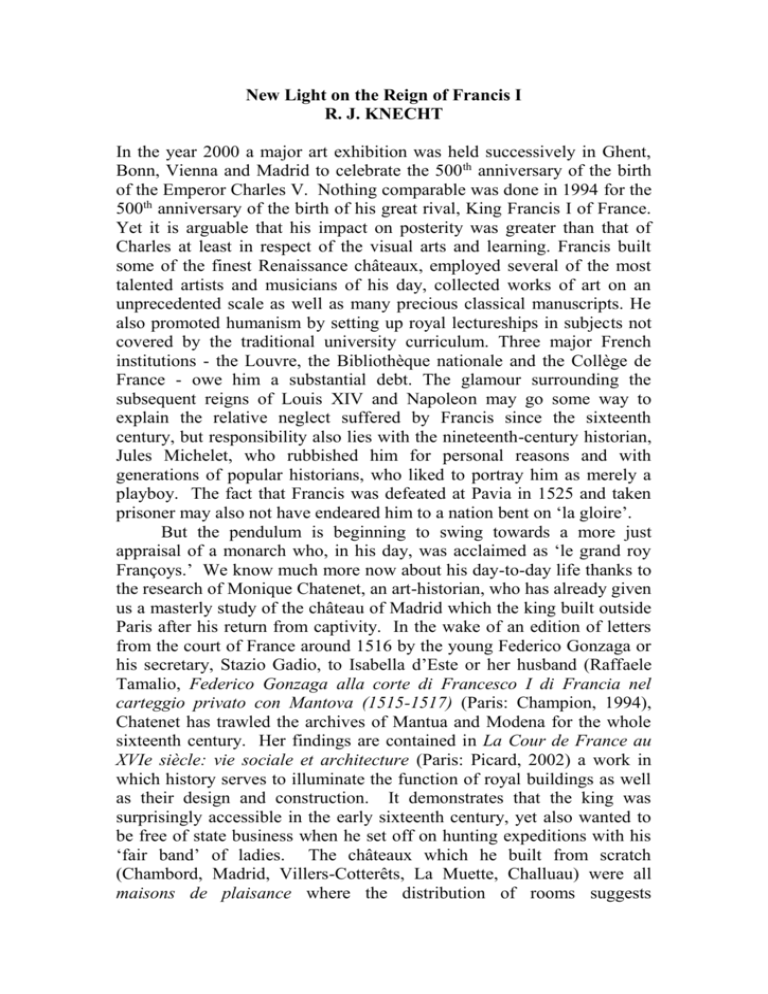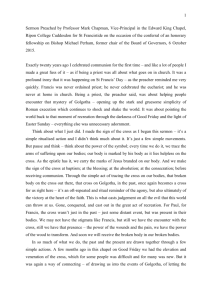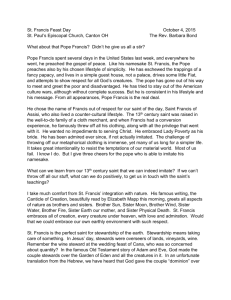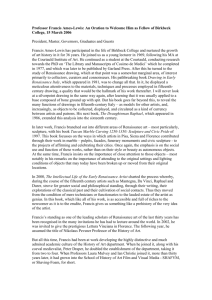New Light on the Reign of Francis I
advertisement

New Light on the Reign of Francis I R. J. KNECHT In the year 2000 a major art exhibition was held successively in Ghent, Bonn, Vienna and Madrid to celebrate the 500 th anniversary of the birth of the Emperor Charles V. Nothing comparable was done in 1994 for the 500th anniversary of the birth of his great rival, King Francis I of France. Yet it is arguable that his impact on posterity was greater than that of Charles at least in respect of the visual arts and learning. Francis built some of the finest Renaissance châteaux, employed several of the most talented artists and musicians of his day, collected works of art on an unprecedented scale as well as many precious classical manuscripts. He also promoted humanism by setting up royal lectureships in subjects not covered by the traditional university curriculum. Three major French institutions - the Louvre, the Bibliothèque nationale and the Collège de France - owe him a substantial debt. The glamour surrounding the subsequent reigns of Louis XIV and Napoleon may go some way to explain the relative neglect suffered by Francis since the sixteenth century, but responsibility also lies with the nineteenth-century historian, Jules Michelet, who rubbished him for personal reasons and with generations of popular historians, who liked to portray him as merely a playboy. The fact that Francis was defeated at Pavia in 1525 and taken prisoner may also not have endeared him to a nation bent on ‘la gloire’. But the pendulum is beginning to swing towards a more just appraisal of a monarch who, in his day, was acclaimed as ‘le grand roy Françoys.’ We know much more now about his day-to-day life thanks to the research of Monique Chatenet, an art-historian, who has already given us a masterly study of the château of Madrid which the king built outside Paris after his return from captivity. In the wake of an edition of letters from the court of France around 1516 by the young Federico Gonzaga or his secretary, Stazio Gadio, to Isabella d’Este or her husband (Raffaele Tamalio, Federico Gonzaga alla corte di Francesco I di Francia nel carteggio privato con Mantova (1515-1517) (Paris: Champion, 1994), Chatenet has trawled the archives of Mantua and Modena for the whole sixteenth century. Her findings are contained in La Cour de France au XVIe siècle: vie sociale et architecture (Paris: Picard, 2002) a work in which history serves to illuminate the function of royal buildings as well as their design and construction. It demonstrates that the king was surprisingly accessible in the early sixteenth century, yet also wanted to be free of state business when he set off on hunting expeditions with his ‘fair band’ of ladies. The châteaux which he built from scratch (Chambord, Madrid, Villers-Cotterêts, La Muette, Challuau) were all maisons de plaisance where the distribution of rooms suggests informality. We are provided with fascinating glimpses of a king who could be at once authoritarian yet genial. We see him ordering all his courtiers to shave their heads because he had been obliged to shave his after an injury or driving around a park in a new sort of carriage or again making a sketch of a building which he has in mind. Monique Chatenet’s Chambord (Paris: Éditions du patrimoine, 2002) is not only superbly illustrated, but also an up-to-date assessment of recent research on the construction of that veritable Taj Mahal of the French Renaissance. Following his return from captivity, Francis shifted the main focus of his building activity from the Loire Valley to the Ile-de-France. He built Madrid, began rebuilding the Louvre and developed Fontainebleau, which allegedly became his favourite residence. It was here that he set to work two famous Italian artists, Rosso and Primaticcio, who with their assistants decorated many parts of the château in a distinctive style, combining painting and stucco. But the château was not planned from the start, it evolved over the years in response to circumstances. Thus, when Louise of Savoy, the king’s mother, died in 1531, he took over her lodging in the keep. As a result a monumental staircase which had been recently built in the oval courtyard to provide access to his lodging was swept away as redundant in spite of the fact that it now led to the presence chamber of Francis’s new queen, Eleonor of Portugal. These and other changes in the château’s plan are admirably described in Françoise Boudon and Jean Blécon, Le Château de Fontainebleau de François Ier à Henri IV (Paris: Picard, 1998). Francis I was immensely proud of the long gallery at Fontainebleau which bears his name. He incorporated it into his apartment, kept the key on his person and showed it to distinguished foreign visitors, like John Wallop in 1540. Much ink has been spilt on the interpretation of the sequence of mural paintings by Rosso. Henri Zerner in his L’Art de la Renaissance en France: L’invention du classicisme (Paris: Flammarion, 1996) admits that the ‘coherent discourse’, which he feels sure links the various subjects in the gallery, has so far eluded him, but he proposes a possible link between its programme and the book of emblems, a genre created by Alciati which achieved great popularity in early sixteenth-century France. The attention recently given to Francis I has not been limited to his patronage of the visual arts. Christine Cazeaux’s La Musique à la cour de François Ier (Paris: École des Chartes, 2002) is a richly documented study of an unfairly neglected topic. Francis may not have been as keen on music as his predecessor Louis XII, but he attracted some leading musicians to his court and established on a more regular footing the Chapel, the Écurie and the Chamber – household departments which, between them, provided him and his entourage with music, choral and instrumental, sacred and secular. Historians have been no less active than art-historians in enlarging our knowledge of Francis I. As is well known, he had to spend a great deal of money on war and diplomacy. Taxation was insufficient to serve his needs. He had to resort to all kinds of expedients, including the sale of offices. Even so, the king was seldom able to balance the books and blamed his fiscal officials for this. One of the few blots on his humane escutcheon is his treatment of Jacques de Beaune, baron of Semblançay, an old man of eighty or so who after giving the king years of loyal service was tried for corruption, sentenced to death and hanged. Many other such fiscal officials were tried for corruption, imprisoned and had their goods confiscated. We now know all that there is to know on the subject of the royal finances thanks to Philippe Hamon’s magisterial study, L’Argent du roi: Les finances sous François Ier (Paris: Comité pour l’histoire économique et financière de la France, 1994). And he has since published an equally impressive study of the king’s fiscal personnel, called “Messieurs des finances”: Les grands officiers de finance dans la France de la Renaissance (Paris: Comité pour l’histoire économique et finacière de la France, 1999). The most obscure part of Francis I’s reign is that which followed the fall of the chief minister, Anne de Montmorency, in 1542. A new generation of ministers began to influence policy. I have been taken to task for devoting only forty pages to these years in my biography of the king. Happily, this deficiency is being remedied by a number of young scholars. François Nawrocki has just completed a monumental thesis on the Admiral Claude d’Annebault, which suggests that the contemporary English assessment of the man as a ‘blockhead’ was anything but just. Nawrocki reveals him to have been an able administrator and diplomat and the king’s chief minister in the last four years of his reign. He describes the traditionally dismissive picture of these years as a ‘vision caricaturale’ which needs urgent revision. It is to be hoped that his thesis will soon be published. Cédric Michon, who is working on the king’s circle of ecclesiastical ministers (and comparing them with their English counterparts) is about to illuminate the career of cardinal Jean de Lorraine, one of the king’s closest friends after 1530. All of this work is beginning to pay dividends for the Renaissance, and Francis I’s reign in particular, are the topic of this year’s aggrégation, the competitive examination for would-be teachers of history. Text-books on the subject are proliferating and a large exhibition glorifying Francis I is planned to take place at Chambord in the summer of 2004. So things are looking up for the ‘roi chevalier’.






